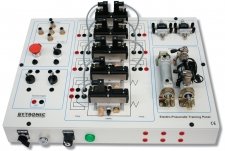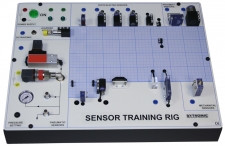-
Electro-Pneumatic Training Panel
ViewThe Electro-Pneumatic Training Panel is a compact and comprehensive training panel comprising cylinders, valves, both electrical and electro-pneumatic, that are easily connected through 4mm colour coded terminals and 4mm pneumatic quick action terminations, this makes the EPTP is an ideal introduction to Electro-Pneumatics. The student can study single and double acting cylinders using various types of valves. The EPTP comprises power supply, On/Off switch with indicator light; emergency stop; two-way selector switch; 5/3 monostable valves, 5/2 monostable valve, 5/2 flip flop Valve, 5/3 open centre valve, 5/3 closed centre valve, flow regulators, single acting cylinder, double acting cylinder and .magnetic reed switches
Courseware covers a general introduction to the EPTP, the electrical and pneumatic connection, the characteristics and use of the various types of valves, the characteristics of the cylinders, how they can be connected to the valves, using a PLC to control the system. The coursework is supplemented by technical documentation.
-
Sensor Training Rig
ViewThe Sensor Training Rig is an introduction to the use of sensors, types of sensors and a teaching aid when studying the application of control, manufacturing or automation. The sensors include infra-red, capacitive, photoelectric, inductive, proximity, fibre-optic and mechanical sensors. The outputs to the sensors are easily accessible through 4mm colour coded terminals on the front of the unit or through a D type connection and can be linked to a PLC or PC for analysis and testing of the sensors.
The STR is supplied with various types of material steel, aluminium, foam, wood, plexiglas, plastic abs, white plastic abs, to provide the student with the facility to compare the effectiveness of the different types of sensors for different types of materials supplied. The student can evaluate the efficiency of the sensors using the various materials. The range and suitability of the sensors can be observed providing the student with the opportunity to make recommendations for the selection of a sensor in particular applications.
-
Automated Production System
ViewThe Automation Production System is comprised of modules with varying functions that are electrically and mechanically linked, and when combined simulate an actual industrial process such as material dispensing, sorting of products, processing, and storing. The APS is designed to enables students to acquire knowledge of automation and production systems using PLC programming with the aid of sensors and actuators in the area of mechatronics.
The APS is constructed on an aluminium frame and can be mounted on a bench or supplied with a support stand. The APS has an operating console with on/off switches, emergency stop switch and PLC control with the I/O connections, electrical and pneumatic.
The functionally of the APS is to allow students to study the automation process and to understand how to control various modules to ensure they work together. The APS uses a bottling plant as the process with containers being placed onto the conveyor belt. The presence/absences of a container is detected using sensors and if present the containers are moved to the linear conveyor system. The linear conveyor moves each container onto the two axis pick and place module where the pneumatic gripper of the transfer unit picks up the container and places it onto the indexing rotary table. The motorised rotary module will index the container through to the volumetric filling modules where the container is filled. The container is then capped at the capping module and the containers are transferred from the rotary module to the weighing module. Once weighing is complete the XY palletising module will store the finished item in the pallet section.
The process allows the control of production using a series of modules that are independently controlled and require the modules to be synchronised for the operation to be performed successfully and is representative of a full-size production system.



